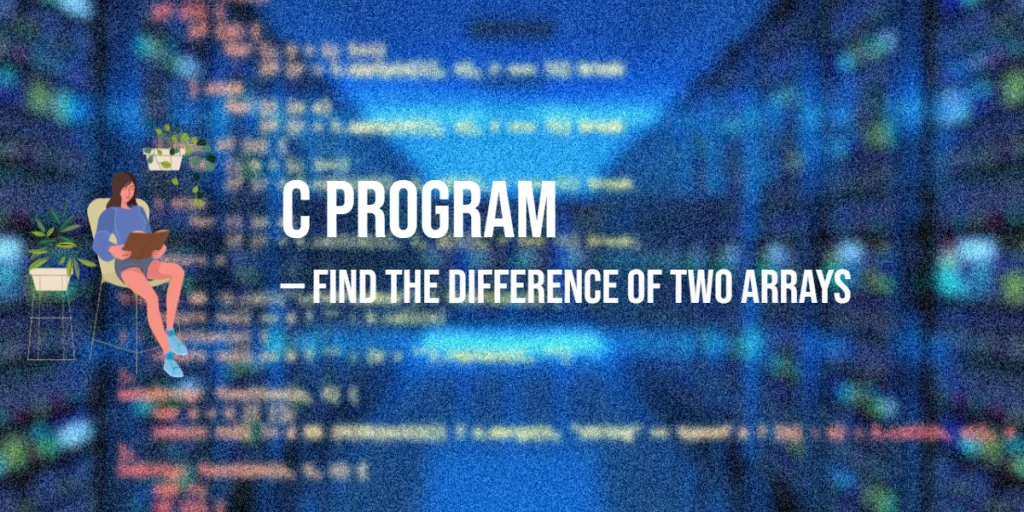In array operations, the difference between two arrays A and B is a new array containing all elements that are in A but not in B. This operation is widely used in data analysis, filtering datasets, and solving algorithmic problems. Learning to compute array differences helps programmers manage data efficiently and manipulate collections of values.

with hands-on learning.
get the skills and confidence to land your next move.
In this tutorial, we will explore multiple methods to find the difference of two arrays in C. Each approach includes full executable code examples and detailed explanations. By the end of this guide, you will understand how to extract elements unique to the first array, avoid duplicates, and implement efficient solutions.
Understanding the Problem
The difference of two arrays A and B is a set of elements present in A but not in B. For example, if:
A = {1, 2, 3, 4}
B = {3, 4, 5, 6}Then the difference is:
Difference = {1, 2}The challenge lies in efficiently identifying which elements are not shared between the arrays, especially when working with large datasets. We will explore methods ranging from simple nested loops to optimized hashing.
Program 1: Using Nested Loops
The most straightforward approach is to check each element of A against all elements of B. If the element is not found in B, it is added to the result array.
#include <stdio.h>
int main() {
int A[] = {1, 2, 3, 4};
int B[] = {3, 4, 5, 6};
int sizeA = sizeof(A) / sizeof(A[0]);
int sizeB = sizeof(B) / sizeof(B[0]);
int result[sizeA]; // difference cannot have more elements than A
int sizeR = 0;
for(int i = 0; i < sizeA; i++) {
int found = 0;
for(int j = 0; j < sizeB; j++) {
if(A[i] == B[j]) {
found = 1;
break;
}
}
if(!found) {
result[sizeR++] = A[i];
}
}
printf("Difference of two arrays (A - B): ");
for(int i = 0; i < sizeR; i++) {
printf("%d ", result[i]);
}
printf("\n");
return 0;
}Here, each element of A is compared against all elements in B. If it is not present in B, it is added to the result array. This method is simple but may be slow for large arrays due to repeated comparisons.
Program 2: Using Sorting and Two Pointers
For better performance, we can sort both arrays and use a two-pointer approach to efficiently find elements in A that are not in B.
#include <stdio.h>
#include <stdlib.h>
int compare(const void *a, const void *b) {
return (*(int*)a - *(int*)b);
}
int main() {
int A[] = {1, 2, 3, 4, 7};
int B[] = {3, 4, 5, 6};
int sizeA = sizeof(A) / sizeof(A[0]);
int sizeB = sizeof(B) / sizeof(B[0]);
int result[sizeA]; // difference cannot have more elements than A
int sizeR = 0;
qsort(A, sizeA, sizeof(int), compare);
qsort(B, sizeB, sizeof(int), compare);
int i = 0, j = 0;
while(i < sizeA) {
if(j >= sizeB || A[i] < B[j]) {
result[sizeR++] = A[i++];
} else if(A[i] == B[j]) {
i++; j++;
} else {
j++;
}
}
printf("Difference of two arrays (A - B): ");
for(int k = 0; k < sizeR; k++) {
printf("%d ", result[k]);
}
printf("\n");
return 0;
}After sorting, the two-pointer approach allows us to traverse both arrays simultaneously. Elements in A that are smaller than the current element in B are added to the result, while equal elements are skipped. This method is faster than nested loops for larger arrays.
Program 3: Using Hashing
For optimal performance with large datasets, we can use a hash table to mark elements of B and quickly check if elements of A are absent in B.
#include <stdio.h>
#include <stdbool.h>
int main() {
int A[] = {1, 2, 3, 4, 7};
int B[] = {3, 4, 5, 6};
int sizeA = sizeof(A) / sizeof(A[0]);
int sizeB = sizeof(B) / sizeof(B[0]);
int max = 100; // assuming all numbers <= 100
bool hash[max+1] = {false};
int result[sizeA]; // safe: difference cannot have more elements than A
int sizeR = 0;
// Mark all elements in B
for(int i = 0; i < sizeB; i++) {
hash[B[i]] = true;
}
// Add elements from A not in B
for(int i = 0; i < sizeA; i++) {
if(!hash[A[i]]) {
result[sizeR++] = A[i];
}
}
printf("Difference of two arrays (A - B): ");
for(int i = 0; i < sizeR; i++) {
printf("%d ", result[i]);
}
printf("\n");
return 0;
}This approach is very fast for large arrays. It uses extra memory to store the hash table but avoids repeated comparisons, making it ideal for performance-critical applications.
Performance Comparison
| Method | Time Complexity | Space Complexity | Notes |
|---|---|---|---|
| Nested Loops | O(n*m) | O(n) | Simple and intuitive, but slow for large arrays. |
| Sorting + Two Pointers | O(n log n + m log m) | O(n) | Fast and memory-efficient; sorting changes element order. |
| Hashing | O(n + m) | O(k) | Very fast; uses extra memory for hash table. |
Which Method Should You Use?
The nested loop method is easiest to understand and suitable for small arrays or practice problems.
The sorting and two-pointer method is efficient for medium-sized arrays and when sorting is acceptable.
The hashing method is ideal for large arrays or when performance is critical, providing speed at the cost of additional memory.
In practice, hashing is often preferred for large datasets, while nested loops or sorting work well for small arrays or educational purposes.
FAQs
Q1: Can this handle negative numbers?
Yes, nested loops and sorting work with negative numbers. Hashing needs adjustment if array indices are used.
Q2: Does this method preserve order?
Nested loops preserve the order of A. Sorting changes order, and hashing does not guarantee order unless additional logic is added.
Q3: Can I compute B - A instead?
Yes, simply swap the roles of A and B in any of the methods above to get the difference of B - A.
Conclusion
Finding the difference of two arrays is a fundamental operation in C programming. We explored nested loops, sorting with two pointers, and hashing techniques. Beginners can start with nested loops for clarity, while hashing is optimal for performance-critical applications. Mastering these techniques improves your array manipulation and problem-solving skills in C.
References & Additional Resources
A curated collection of textbooks and tutorials for learning arrays, array operations, and hashing techniques in C.
- Kernighan, Brian W., and Dennis M. Ritchie. The C Programming Language, 2nd Edition, Prentice Hall, 1988 – The foundational text covering arrays, pointers, functions, and core C programming concepts.
- GeeksforGeeks: C Arrays – Introduction to arrays in C, including declaration, initialization, traversal, and basic operations.
- GeeksforGeeks: Symmetric Difference of Sets – Demonstrates how to find the difference of two arrays with C programming examples.
- GeeksforGeeks: Hashing in Data Structure – Explains the concept of hashing, hash tables, and their applications for efficient data storage and retrieval.







